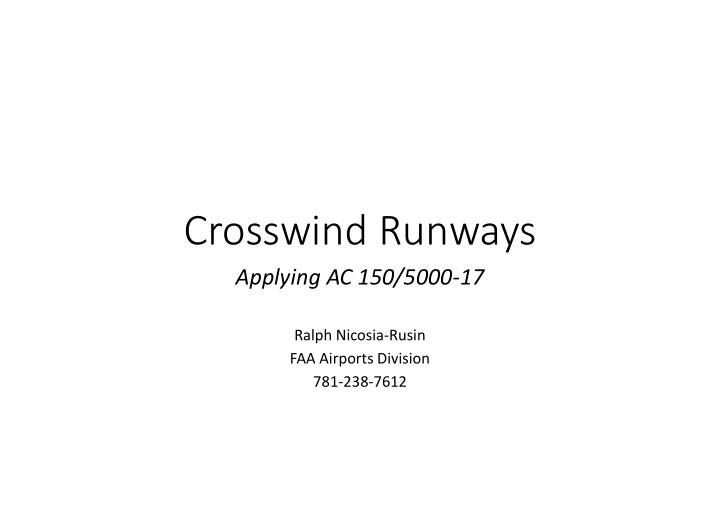



Crosswind Runways Applying AC 150/5000-17 Ralph Nicosia-Rusin FAA Airports Division 781-238-7612
What’s changed? • Prior convention • Assumed maintenance of existing crosswinds. • Unless substantial costs or land required for other aviation purpose. • Same design code as primary. • Length should be 80% of primary runway. • AC 150/5000-17 par 3.3.2, “Separate Critical Aircraft Determination for Each Runway at an Airport.” The determination of the Critical Aircraft for a crosswind runway requires meeting both the wind coverage requirements as specified in AC 150/5300-13, Airport Design, and the regular use requirements for the aircraft that would use the crosswind runway. See Paragraph 3.8.
Example: Wind Coverage Calculations Equivalent Annual Operations = 500 / GAP PRIMARY COMBINED GAP REQ. ANNUAL OPs 10.5 92% 96% 4% 12,500 AAC= A knots 13 94% 97% 3% 16,666 AAC= B knots • Operations =total landings + departures (no touch and go operations). • Alternatively show regular use by documenting aircraft actually using the runway. • Note: Annual operations reported in TAF and 5010 are not sufficient for airport planning without other validation.
Runway dimensions • If you only have wind coverage for approach category A aircraft, it is unlikely you can justify pavement widths for Group II. • Category A and B use the same runway length chart. In most instances this supports 3,000 to 3,200 ft. • Can you avoid intersections and the RVZ? • The airport can reconstruct current dimensions, but AIP grant funding will typically be limited to that portion of the project that meets FAA standards. (par. 3.15.1)
Planning Considerations • These criteria are developed to guide new construction. • Refinements to policy are being considered for proper application to existing runways that exceed needs. • Until then, ANE-600 cannot support AIP funding of runways that have inadequate justification. • ADS-B can produce data on individual runway usage but not a 100% unless supplemented by G.A.R.D. or other method.
Other Considerations • Do you have reliable wind data? • What does it cost your airport to plow and maintain the crosswind runway? • If the runway is not plowed in the winter, how does that factor into justifying its need? • Would the corridor be better used for other user needs or for non- aeronautical revenue generation for the airport? • Is there a plausible scenario that would alter the need for a crosswind runway?
Recommend
More recommend